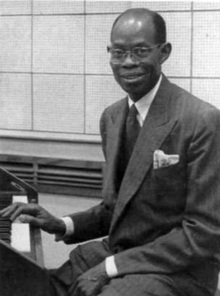
Edward Kennedy "Duke" Ellington was an American jazz pianist, composer, and leader of his eponymous jazz orchestra from 1923 through the rest of his life.

Rhapsody in Blue is a 1924 musical composition for solo piano and jazz band, which combines elements of classical music with jazz-influenced effects. Commissioned by bandleader Paul Whiteman and written by George Gershwin, the work premiered in a concert titled "An Experiment in Modern Music" on February 12, 1924, in Aeolian Hall, New York City. Whiteman's band performed the rhapsody with Gershwin playing the piano. Whiteman's arranger Ferde Grofé orchestrated the rhapsody several times including the 1924 original scoring, the 1926 pit orchestra scoring, and the 1942 symphonic scoring.

Ferdinand Rudolph von Grofé, known as Ferde Grofé was an American composer, arranger, pianist, and instrumentalist. He is best known for his 1931 five-movement symphonic poem, Grand Canyon Suite, and for orchestrating George Gershwin's Rhapsody in Blue for its 1924 premiere.
Program music or programmatic music is a type of instrumental art music that attempts to musically render an extramusical narrative. The narrative itself might be offered to the audience through the piece's title, or in the form of program notes, inviting imaginative correlations with the music. A well-known example is Sergei Prokofiev's Peter and the Wolf.

Hugo Emil Alfvén was a Swedish composer, conductor, violinist, and painter. Alfvén was one of Sweden's principal composers. His "Swedish Rhapsody”, written when he was 31, is still one of the best-known pieces of Swedish music. After extensive European travels to develop his musical skills, Alfvén taught composition, before conducting choirs and orchestras. In 1954 he made the first Swedish classical stereo recordings. Hugo Alfvén’s extensive musical archive is held at Uppsala University, where he was music director for twenty nine years.
Concerto in F is a composition by George Gershwin for solo piano and orchestra which is closer in form to a traditional concerto than his earlier jazz-influenced Rhapsody in Blue. It was written in 1925 on a commission from the conductor and director Walter Damrosch. A full performance lasts around half an hour.

American classical music is music written in the United States in the Classical music tradition, which originated in Europe. In many cases, beginning in the 18th century, it has been influenced by American folk music styles; and from the 20th century to the present day it has often been influenced by American folk music and sometimes jazz.

Chief Olufela Obafunmilayo "Fela" Sowande MBE was a Nigerian musician and composer. Considered the father of modern Nigerian art music, Sowande is perhaps the most internationally known African composer of works in the European "classical" idiom.
Ernest Tomlinson MBE was an English composer, particularly noted for his light music compositions. He was sometimes credited as 'Alan Perry'. Tomlinson wrote over 100 pieces of library music, thirteen orchestral suites, symphonic works and music for brass band.

Ahmad Pejman, also spelled as Ahmad Pezhman, is an Iranian contemporary classical composer who resides in the United States. Pejman is notable for his works in opera, symphonies, and music for film.
Orchestral jazz or symphonic jazz is a form of jazz that developed in New York City in the 1920s. Early innovators of the genre, such as Fletcher Henderson and Duke Ellington, include some of the most highly regarded musicians, composers, and arrangers in all of jazz history. The fusion of jazz's rhythmic and instrumental characteristics with the scale and structure of an orchestra, made orchestral jazz distinct from the musical genres that preceded its emergence. Its development contributed both to the popularization of jazz, as well as the critical legitimization of jazz as an art form.
John Wilson is a British conductor, arranger and musicologist, who conducts orchestras and operas, as well as big band jazz. He is the artistic director of Sinfonia of London.
Third stream is a music genre that is a fusion of jazz and classical music. The term was coined in 1957 by composer Gunther Schuller in a lecture at Brandeis University. There are many ways to define third-stream music. It could refer to a group of jazz musicians playing solely, or a jazz soloist performing with a symphony orchestra, as long as the musicians are able to interpret and play jazz music. Improvisation is generally seen as a vital component of third stream. In third-stream music, composers incorporated elements of classical music, such as the use of jazz instruments and classical music forms, into their jazz compositions. The fusion of jazz and classical music is also viewed as "born out of a reciprocal interest: the interest of the classical community in the developments in jazz music and the interest of the jazz community in the advances of classical music." The innovative idea of fusing jazz and classical music pushed the boundaries of traditional classical music and introduced a new genre that blends the two styles into a unique hybrid form.
"Black and Tan Fantasy" is a 1927 jazz composition by Duke Ellington and Bubber Miley. The song was recorded several times by Ellington and his Cotton Club band in 1927 for the Brunswick, Victor, and Okeh record labels. The Victor recording was inducted into the Grammy Hall of Fame.

Allan Zavod was an Australian pianist, composer, jazz musician and occasional conductor whose career was mainly in America.
Harlem is a symphonic jazz composition by the American composer Duke Ellington.
Thomas Christopher Kelly was an Irish composer, teacher and conductor.
Charles Cozens is involved in the music industry in Canada as an arranger for solo artists; a composer writing in multiple genres for diverse organizations including chamber ensembles, musical theatre, and television; a conductor and producer of crossover orchestral shows; a performer on piano and accordion in jazz, classical, and pop styles; and as a recording artist and producer.








